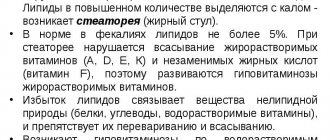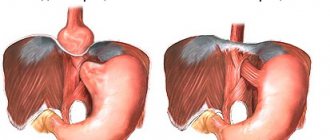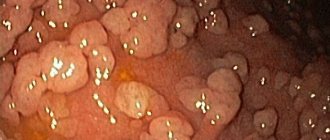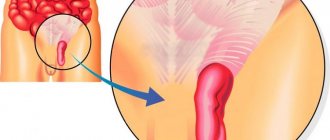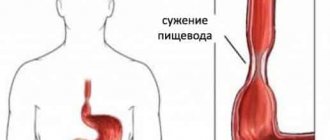A hernia is a pathological formation characterized by protrusion or displacement of organs and their parts from their usual locations into other cavities, outward.
Several conditions are necessary for the formation of a hernia:
- The presence of a hollow organ;
- The cavity into which the displacement occurs;
- The dividing line between the normal and pathological location of the organ.
All these conditions are also suitable for the stomach.
The stomach is a hollow organ of the digestive tract. Any of its walls or sections can shift under the influence of certain factors; the diaphragm serves as the boundary. It divides the human body into two parts: thoracic and abdominal.
The diaphragm has an esophageal opening; normally the esophagus and blood vessels pass through it. With pathological changes, the stomach can protrude into it; the thoracic part of the body serves as the cavity.
Hernia in the stomach - what is it?
A gastric hernia is a change in the position of an organ or its parts relative to the diaphragm. Normally, the stomach is completely immersed in the abdominal cavity, its parts do not penetrate into the overlying sections.
When a hernia occurs, the wall protrudes into the chest cavity through the esophageal opening. The most dangerous condition is the complete displacement of the stomach into the chest.
The phenomenon occurs when the retaining muscles of the diaphragm are stretched and weakened, with a persistent and prolonged increase in intra-abdominal pressure.
The hernia consists of the hernial orifice, the hernial sac and the hernial contents. The hernial orifice is represented by the esophageal opening of the diaphragm.
The hernial sac consists of layers of the gastric wall and layers of the diaphragm itself, and the hernial contents are the wall that has changed its anatomical location.
Complicated hernia
A severe course is typical for a complicated gastric hernia. This disease is accompanied by necrotic changes in the organ, inflammation, malignant degeneration, strangulation, and bleeding.
A diaphragmatic gastric hernia can bulge inward or outward. With external protrusion, the abdominal walls protrude through weakened areas of the diaphragm. Internal hernias are characterized by migration of peritoneal organs into the sternum cavity through physiological openings in the diaphragm.
Before we talk about the treatment of gastric hernia, we will describe the reasons.
Causes
For the development of the disease, several conditions must form: increased intra-abdominal pressure, incompetence of the diaphragm, its ligaments and muscular apparatus, diseases of the stomach and esophagus. Most often, the disease occurs in older people, mostly in men.
Doctors identify a number of causes and conditions that contribute to the development of the disease.
These include:
- Age over 55 years.
The older a person gets, the weaker his muscular system becomes. This applies not only to the musculoskeletal system, but also to internal organs.
The diaphragm muscles stretch, wear out, and become less elastic. This affects the change in the anatomical location of the organs adjacent to the diaphragm, and a hernia occurs.
- Prolonged increase in intra-abdominal pressure.
There is some difference in pressure between the chest and abdominal cavities. Due to it, the respiratory act and other physiological processes occur. When abdominal pressure predominates over thoracic pressure, organs are pushed into a cavity with less pressure.
- Chronic diseases of the gastrointestinal tract, pulmonary apparatus, cardiovascular system.
Doctors include obstructive pulmonary disease, heart failure, cirrhosis of the liver, stomach ulcers, and cancer.
- Strong physical activity.
As a result, atrophy of the diaphragm, its movement, and increased pressure in the subdiaphragmatic zone can occur.
- Pregnancy in the third trimester.
It is complicated in women who had diseases of the stomach, esophagus, lungs or heart before pregnancy.
- Congenital anomalies of the esophagus, stomach, diaphragm.
- Excess body weight.
People who are overweight very often encounter hernial protrusions:
- Injury in the abdominal or thoracic area.
- Abdominal or thoracic surgical interventions.
- Connective tissue diseases: scleroderma, systemic lupus erythematosus and others.
- Chronic constipation.
- Frequent overeating.
Symptoms
- Heartburn
- Pain
- Problematic passage of food through the esophagus
- Belching
- Hoarseness in the voice
Gastric hernia, symptoms, treatment are directly related to the presence of concomitant diseases. If the hernia is small, then there may be no symptoms, the patient feels great. As the hernia increases, complications develop and secondary diseases occur.
Heartburn, belching, burning and acute pain localized in the epigastrium, hypochondrium or behind the sternum may occur. The patient thinks that his heart hurts, and he begins to be treated by a cardiologist.
Frequent release of gastric juice into the esophagus and oral cavity causes a peptic burn, the voice becomes hoarse, and pain is felt in the tongue and throat. Irritation of the vagus nerve provokes hiccups, which are constant and persistent and cannot be stopped.
The passage of food through the esophagus becomes difficult and causes pain. This is caused by spasm of the esophageal wall. The patient experiences a painful sensation of food being stuck.
Symptoms, signs and treatment of hernia in the stomach in adults
Only an experienced specialist can give a complete, detailed diagnosis based on characteristic symptoms when prescribing laboratory and instrumental research methods.
If you detect certain signs, you should not diagnose yourself; it is better to consult a doctor.
The following symptoms and signs are characteristic of a gastric hernia:
- Pain in the stomach area.
Pain of a pulling or aching type. First it appears after errors in the diet, then a painful symptom is noted after each meal. When the affected area becomes larger, the pain becomes acute.
This symptom is similar to a heart attack or angina. Painful sensations can subsequently spread throughout the abdomen, radiating to the back, lower back, and neck.
- Severe constant heartburn.
Patients note that even after drinking ordinary water, symptoms can be provoked. It is painful. It can be eliminated with medications, but not for long.
- Profuse belching.
Belching is the return of eaten contents or food elements to the upper digestive tract. This symptom always accompanies pathology. The difference from belching with gastritis or a stomach ulcer is that it appears almost immediately after eating.
- Vomit.
Associated with a decrease in the volume of the stomach, its displacement into a pathological area, and disruption of its digestive functions.
- Subjective feeling of “coma” in the esophagus or behind the sternum.
- A special symptom is a prolonged dry cough.
It does not depend on lung pathology and is not associated with cold factors. This cough cannot be treated with standard antitussive medications.
- Hoarseness of voice, constant feeling of soreness in the throat.
- Impaired passage of the food bolus through the esophagus.
At first it is difficult to pass solid rough food, then crushed food. As the later stages develop, the patient has difficulty swallowing liquid foods and drinking water.
- Cardiac disorders may occur: increased heart rate, increased blood pressure, shortness of breath.
- Dyspeptic symptoms: diarrhea, constipation, indigestion.
- Visual protrusion under the skin in the epigastric region.
Diagnostics
If symptoms of gastrointestinal disturbances appear, the patient should consult a gastroenterologist. To diagnose a hernia and differentiate it from other pathologies of the gastrointestinal tract, instrumental studies are carried out:
- FGDS (fibrogastroduodenoscopy) - a flexible probe equipped with a miniature optical system is inserted into the esophagus. The image is displayed on the monitor screen. During such a study, the doctor can examine in detail the mucous membranes of the digestive canal from the esophagus to the duodenum. FGDS is the most informative diagnostic method and is prescribed to all patients, without exception, who complain of the digestive problems listed above.
- X-ray examination - prescribed to patients in whom the doctor suspects the presence of a hernia. The procedure is based on the introduction of a contrast agent into the gastrointestinal tract, after which a series of photographs are taken. The study allows us to identify not only the presence of a hernia, its size, location, but also narrowing of the esophagus, changes in the mucous membranes of the gastrointestinal tract, the presence of inflammatory processes of the esophagus and stomach in the acute stage. If the study is not informative, the patient is prescribed a pH-metry method.
- pH metry - this study allows you to determine the presence of reflux of stomach contents into the esophagus and their frequency. The procedure is carried out using a special device, during which an electrode is installed through the patient’s nose, which records any changes in the acidity of gastric juice on a fixed block. The data from these changes is processed by computer programs and allows the doctor to give the patient an accurate diagnosis.
All diagnostic procedures are performed on an empty stomach and require special preparation of the patient. On the day of the study, it is forbidden to drink water, take medications, or smoke, as this may affect the diagnostic information.
How dangerous is the disease?
This is a serious disease that can cause severe complications that are dangerous to the health and life of the patient. It needs to be diagnosed and treated as soon as possible.
The disease is dangerous due to the following symptoms:
- Strangulated hernia.
In this case, compression of part of the organ occurs in the area of the hernial orifice. With such prolonged exposure, blood flow is disrupted. The tissues do not receive the necessary substances, quickly die and die, and necrosis occurs. Gastric gangrene may develop.
This condition is manifested by severe acute pain, pallor of the patient, cold sweat, high pulse and blood pressure. Requires urgent surgical intervention.
- Perforation of the organ wall.
Perforation means the formation of a hole in the wall. Gastric contents are poured into the internal environment of the body, and diffuse peritonitis and sepsis can form. It also requires urgent surgical intervention.
- Internal bleeding.
An insidious complication that may not initially manifest itself. But large blood loss is very dangerous for human life. It manifests itself as pallor, anemia, vomiting mixed with blood, tarry black feces, and is treated promptly.
- Disruption of digestion processes and the entry of important elements into the body.
- Transition of a hernia into a malignant neoplasm.
If the disease persists for a long time, mutation processes can occur. Cell atypia and dysplasia of the damaged area will occur, all of which can cause cancer.
- Intestinal obstruction.
Causes of this problem
Gastric hernias are pathologies mainly affecting the elderly and senile age. If only 9% of children suffer from hyperthyroidism, then among people over 70 years old it is already 69%.
This happens because, due to the natural processes of aging, the connective tissues in the body lose their elasticity and atrophy (this also applies to the connective tissue ligaments of the POD). Conditions are created that are favorable for the development of hernial protrusion.
The factor that provokes the formation of a hernia is usually an increase in intra-abdominal pressure. Elderly people usually already have concomitant diseases and conditions (chronic diseases of the lungs, intestines, excess weight, etc.) that provoke an increase in intra-abdominal pressure.
Most often, a gastric hernia develops in patients:
- With constipation.
- With bloating.
- With vomiting.
- With a hacking cough.
- Obese.
- With connective tissue diseases. Congenital weakness of the ligaments is indicated by Marfan syndrome (a congenital disease characterized by impaired development of connective tissue), varicose veins, flat feet and some other diseases.
Another common cause of breastfeeding is heavy lifting and repeated pregnancies in women.
In children, gastrointestinal tract develops as a result of developmental disorders of the esophagus in the prenatal period. An abnormally short esophagus pulls the stomach with it into the chest cavity.
PUD – duodenal ulcer, CCC – chronic calculous cholecystitis.
Consequences of the disease
A gastric hernia as a disease must be treated, otherwise it can provoke serious consequences; the hernia itself will not resolve. In the early stages, the consequence of a hernia may be a change in the digestive characteristics of the stomach.
Its secretory activity is disrupted, and diseases such as gastritis and gastric ulcer occur. In extreme cases, cancer may appear.
In more advanced stages, not only the stomach suffers, but also nearby organs. Esophagitis is added - inflammation of the esophageal mucosa.
The patient begins to suffer from shortness of breath, heart failure, liver and pancreas problems. Pancreatitis, cholelithiasis, and hepatitis may develop.
In the later stages, complications appear: strangulated hernia, bleeding, perforation. These conditions require immediate emergency care.
Treatment of gastric hernia with folk remedies
In some cases, the use of traditional methods of treating gastric hernia is allowed. However, self-medication is unacceptable, and the possibility of using alternative methods should be agreed with the doctor.
In general, reviews about the treatment of gastric hernia with folk remedies are positive.
Alternative medicine can eliminate such unpleasant symptoms of the disease as inflammation, pain, bloating, and heartburn.
What is the treatment with folk remedies for a gastric hernia?
Treatment of gastric hernia
Treatment without surgery is possible in the earliest stages of the pathology. In this case, the patient must follow a strict diet and drug therapy.
The course of treatment can be determined by a doctor; you should not self-medicate.
Nutrition and diet
Diet during illness is lifelong. As soon as improvement occurs and the patient quits the diet, all symptoms immediately return.
Doctors recommend:
- Eat food in small portions, but often. On average, there should be 5-6 meals per day.
- Don't eat at night! Last dose 3 hours before bedtime.
- After eating, do not lie down for an hour. Digestion is best done in a sitting position, then you can take a light walk.
- Chew food thoroughly and for a long time.
- Food must be well mechanically processed and ground.
- Do not eat hot food. It should be warm for comfortable passage through the esophagus and stomach.
- It is recommended to sleep with the head of the bed raised, 45 degrees.
- Avoid active physical activity and heavy lifting.
- Do not wear tight clothing.
What not to eat:
- Everything fried, smoked, spicy, salted, canned, fatty.
- Carbonated drinks, alcoholic drinks, juices.
- Poorly processed food.
- Sandwiches, made-to-measures, fast food.
- Complete smoking cessation.
What is allowed for use:
- A gentle diet. The food is ground, thermally processed, not hot.
- Steamed dishes. Steamed vegetables.
- Boiled poultry: chicken or turkey.
- Porridge on the water.
- Boiled fish.
- Not hot teas, herbal decoctions.
- Fruits: bananas, kiwi, apples. Better in a ground form.
Tips for treating a hernia
If you follow some simple rules, this will help you quickly get rid of the unpleasant symptoms of this pathology:
- If you put ice on the hernia site, the pain will go away.
- You can use a compress made from oak bark, which you need to leave for 30 minutes.
- Before treating a hernia, the cause of its occurrence (overeating, bad habits) should be eliminated.
- Meals should be frequent and portions small. It is better not to eat at night.
- Avoid unhealthy foods and carbonated drinks.
- Constipation and flatulence are also prevented by proper nutrition.
- After eating, it's good to go for a walk.
- Don’t forget about gymnastics; all exercises should be done without tension.
How to treat a gastric hernia without surgery, with medications
Conservative therapy without surgery is reduced to the use of pharmacological drugs. The main goal of therapy is to relieve inflammation, reduce gastric secretion, eliminate pain symptoms, and restore digestion.
Antibacterial therapy is prescribed to eliminate inflammatory reactions.
Broad-spectrum drugs are prescribed:
- To eliminate heartburn and belching, proton pump inhibitors are used: Omez, Emanera.
- To protect the mucous membranes of organs, antacids are used: Almagel, Maalox, Reni.
- Eliminate nausea and vomiting with prokinetics: Cerucal.
To relieve pain, it is best to use antispasmodics: Drotaverine, Papaverine.
All dosages, duration of use, frequency of administration are prescribed by the attending physician. Many drugs have side effects and unwanted reactions. All this must be taken into account during therapy.
Treatment methods
Most often, gastric hernia is treated with conservative methods. Conventionally, there are three stages of therapy:
1 Strict diet. It lies in the principle of fractional and proper nutrition.
2 Taking medications prescribed by the attending physician after diagnosis. There are three types of medications for the treatment of gastric hernia:
- antisecretory (Lansoprazole, lansoprazole, omeprozole). They are aimed at reducing acidity and the amount of gastric juice;
- laxatives and drugs necessary to increase muscle tone (Motilium, Cerucal);
- antacids, drugs used to neutralize hydrochloric acid, which is produced along with gastric juice.
3 Quitting bad habits, smoking, drinking alcohol, eating unhealthy foods.
Surgical intervention is prescribed in the following cases:
- large hernia (a gastric hernia is operated on if it occupies 1/3 of the size of the esophagus);
- pinched hernia;
- with the development of complications (narrowing of the esophagus, bleeding);
- advanced cases that interfere with normal digestion and are not treated with medication;
- severe esophagitis (inflammation of the soft tissues of the esophagus);
- abnormal structure of the esophagus.
The most common method used for surgery is laparoscopy. With this method, the operation is quick and less traumatic. Contraindications for surgical intervention include pregnancy, diabetes, cancer, diseases of the cardiovascular system
.
Video
Professor Elena Malysheva talks about hernia treatment methods in her program.
What is an intestinal hernia and how to treat it, read here.
Hernia surgery
In case of late detection of a hernia, its large size, or complications, surgical interventions are necessary.
The operation is carried out in two ways:
- Open - through an incision in the abdominal wall,
- Closed laparoscopic - using small punctures.
Operation technique
First, optimal access to the damaged organ is found, then the hernial sac is excised. All walls of the stomach and esophagus are examined to ensure that there are no complications.
The patency of the digestive tract organs is checked, and the stomach is returned to its anatomical place. A protective retaining mesh is applied (it prevents recurrence of the disease), and the esophageal opening of the diaphragm is sutured.
general information
Let's take a clear look at hernias in the stomach, what they are and how they manifest themselves. The peculiarity of a gastric hernia is that through the wall of the diaphragm, part of the stomach enters the chest cavity. Common is a type of hiatal hernia. In addition, a hernia of the esophagus and stomach very rarely manifests itself and usually occurs without symptoms. Pathology is diagnosed by conducting research on other diseases.
To a person who does not fully understand the essence of education:
- A person has a chest and abdominal cavity, which are separated from each other by a diaphragm, through the opening of which the esophagus passes. If the opening between the esophagus and the stomach becomes loose, the stomach and part of the abdominal esophagus may leak into the chest cavity due to increased intra-abdominal pressure. In this case, the protrusion can be complete or partial
If detected early, a hiatal hernia is not dangerous; if the gastric hernia is treated according to all the doctor’s recommendations, positive dynamics will not be long in coming.
Important! The advantage of a gastric hernia is that in approximately 95% of all cases it is treated conservatively, that is, by using special medications and following a diet. For the stomach, treatment by surgery is used only for serious complications. Moreover, statistics say that after operations there are no relapses.
Diagnostic methods
A gastric hernia can be suspected based on clinical symptoms and diagnosed already during gastroscopy, chest x-ray or digestive system organs.
To clarify the diagnosis (determine the degree of hernia and the presence of complications, exclude the development of a tumor process in the hernia area), additional studies are carried out:
- biopsy of the wall of the esophagus, stomach;
- examination of feces for occult blood;
- determination of atmospheric pressure and PH in the stomach and esophagus.
Gastroscopy allows you to visually assess the condition of the stomach. The study is carried out using an endoscope - a flexible tube at the end of which a flashlight and a video camera are installed (the image from it is displayed on the monitor)

